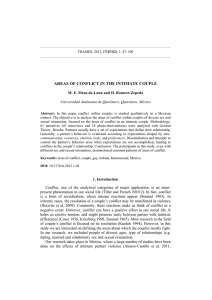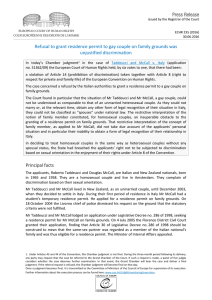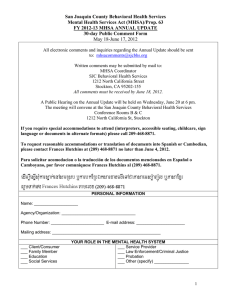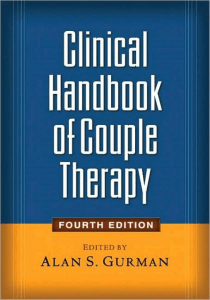Integrative Behavioral Couple Therapy (IBCT) as a
Anuncio
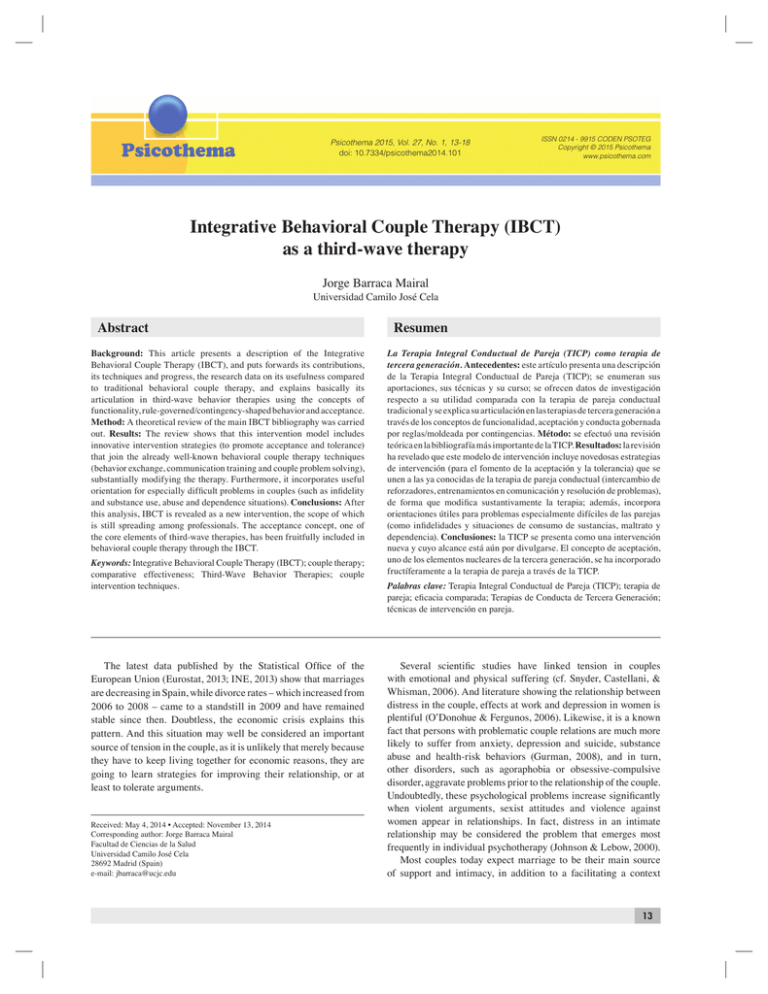
Psicothema 2015, Vol. 27, No. 1, 13-18 doi: 10.7334/psicothema2014.101 ISSN 0214 - 9915 CODEN PSOTEG Copyright © 2015 Psicothema www.psicothema.com Integrative Behavioral Couple Therapy (IBCT) as a third-wave therapy Jorge Barraca Mairal Universidad Camilo José Cela Abstract Background: This article presents a description of the Integrative Behavioral Couple Therapy (IBCT), and puts forwards its contributions, its techniques and progress, the research data on its usefulness compared to traditional behavioral couple therapy, and explains basically its articulation in third-wave behavior therapies using the concepts of functionality, rule-governed/contingency-shaped behavior and acceptance. Method: A theoretical review of the main IBCT bibliography was carried out. Results: The review shows that this intervention model includes innovative intervention strategies (to promote acceptance and tolerance) that join the already well-known behavioral couple therapy techniques (behavior exchange, communication training and couple problem solving), substantially modifying the therapy. Furthermore, it incorporates useful orientation for especially difficult problems in couples (such as infidelity and substance use, abuse and dependence situations). Conclusions: After this analysis, IBCT is revealed as a new intervention, the scope of which is still spreading among professionals. The acceptance concept, one of the core elements of third-wave therapies, has been fruitfully included in behavioral couple therapy through the IBCT. Keywords: Integrative Behavioral Couple Therapy (IBCT); couple therapy; comparative effectiveness; Third-Wave Behavior Therapies; couple intervention techniques. The latest data published by the Statistical Office of the European Union (Eurostat, 2013; INE, 2013) show that marriages are decreasing in Spain, while divorce rates – which increased from 2006 to 2008 – came to a standstill in 2009 and have remained stable since then. Doubtless, the economic crisis explains this pattern. And this situation may well be considered an important source of tension in the couple, as it is unlikely that merely because they have to keep living together for economic reasons, they are going to learn strategies for improving their relationship, or at least to tolerate arguments. Received: May 4, 2014 • Accepted: November 13, 2014 Corresponding author: Jorge Barraca Mairal Facultad de Ciencias de la Salud Universidad Camilo José Cela 28692 Madrid (Spain) e-mail: [email protected] Resumen La Terapia Integral Conductual de Pareja (TICP) como terapia de tercera generación. Antecedentes: este artículo presenta una descripción de la Terapia Integral Conductual de Pareja (TICP); se enumeran sus aportaciones, sus técnicas y su curso; se ofrecen datos de investigación respecto a su utilidad comparada con la terapia de pareja conductual tradicional y se explica su articulación en las terapias de tercera generación a través de los conceptos de funcionalidad, aceptación y conducta gobernada por reglas/moldeada por contingencias. Método: se efectuó una revisión teórica en la bibliografía más importante de la TICP. Resultados: la revisión ha revelado que este modelo de intervención incluye novedosas estrategias de intervención (para el fomento de la aceptación y la tolerancia) que se unen a las ya conocidas de la terapia de pareja conductual (intercambio de reforzadores, entrenamientos en comunicación y resolución de problemas), de forma que modifica sustantivamente la terapia; además, incorpora orientaciones útiles para problemas especialmente difíciles de las parejas (como infidelidades y situaciones de consumo de sustancias, maltrato y dependencia). Conclusiones: la TICP se presenta como una intervención nueva y cuyo alcance está aún por divulgarse. El concepto de aceptación, uno de los elementos nucleares de la tercera generación, se ha incorporado fructíferamente a la terapia de pareja a través de la TICP. Palabras clave: Terapia Integral Conductual de Pareja (TICP); terapia de pareja; eficacia comparada; Terapias de Conducta de Tercera Generación; técnicas de intervención en pareja. Several scientific studies have linked tension in couples with emotional and physical suffering (cf. Snyder, Castellani, & Whisman, 2006). And literature showing the relationship between distress in the couple, effects at work and depression in women is plentiful (O’Donohue & Fergunos, 2006). Likewise, it is a known fact that persons with problematic couple relations are much more likely to suffer from anxiety, depression and suicide, substance abuse and health-risk behaviors (Gurman, 2008), and in turn, other disorders, such as agoraphobia or obsessive-compulsive disorder, aggravate problems prior to the relationship of the couple. Undoubtedly, these psychological problems increase significantly when violent arguments, sexist attitudes and violence against women appear in relationships. In fact, distress in an intimate relationship may be considered the problem that emerges most frequently in individual psychotherapy (Johnson & Lebow, 2000). Most couples today expect marriage to be their main source of support and intimacy, in addition to a facilitating a context 13 Jorge Barraca Mairal for their personal development. That is why, when expectations are frustrated and marital discord is recurrent, a wide variety of problems are observed in both adults and children (Gurman, 2008). Snyder et al. (2006) suggest that, regardless of whether there is a divorce, in many, if not the majority of marriages, the experience of periods of intense distress places both spouses at serious risk of developing symptoms of anxiety and depression. At the same time, a stable, mutually satisfactory couple relationship is associated with mutual benefits for the spouses and their children (Halford & Snyder, 2012). Couple intervention has been proposed as the therapeutic alternative for these problems. According to Johnson and Lebow (2000), its acceptance and application has increased considerably during the last decade, and it is no longer considered a last resort. The American Association of Marital and Family Therapy (AAMFT) reports a growing number of couple therapists, which already has over 20,000 specialized members (Johnson & Lebow, 2000). Behavioral couple therapy The couple intervention text by Jacobson and Margolin (1979) was a basic milestone in behavioral therapy and it spread knowledge of a proven treatment method with clear principles among behavioral therapists. It is true that there were already prior studies by other authors which had dealt with similar aspects (Azrin, Naster, & Jones, 1973; Vincent, Weiss, & Birchler, 1975), but it was the monograph cited that generally opened the field to behavioral psychologists. The axes of traditional behavioral couple therapy intervention were behavior exchange and communication and problem-solving skills training (Dimidjian, Martell, & Christensen, 2008; Jacobson & Margolin, 1979), which emphasized the importance of positive change in the dynamics of the couple. These two components followed each other chronologically, because it was found that couples with problems first had to improve their relational climate (through behavior exchange) in order to later be able to negotiate and arrive at agreements satisfactory to both partners (using communication skills, and finally, problem solving). It was a short intervention (lasting about twenty sessions) with a clear protocol (following the manual by Jacobson and Margolin, 1979, itself), with “micro” (for example, the number of times the couple went out to dinner) and “macro” (for example, how much intimacy was recovered) goals, in addition to working at home and progressive implementation of real daily problems in the skills acquired during the session. This intervention has been empirically evaluated by rigorous research, where meticulous attention was given to couples’ inclusion criteria, therapists’ following the intervention protocol properly and scales used. At least twenty randomized trials were performed (Jacobson, Christensen, Prince, Cordova, & Eldridge, 2000), and the combined results were very satisfactory compared with the rest of the interventions designed for marital problems. However, it was also evident that there were limitations with regard to its ability to produce positive change in couples with especially severe problems (Snyder, Mangrum, & Wills, 1993), in older spouses (Baucom & Hoffman, 1986; cited by Cordova, Jacobson, & Christensen, 1998), in emotionally estranged couples (Hahlweg, Schindler, Revenstorf, & Brengelmann, 1984; cited by Cordova et al., 1998; Johnson & Lebow, 2000), in couples with 14 very polarized gender roles (Jacobson & Addis, 1993; Jacobson, Follette, & Pagel, 1986) and in couples with clearly different goals (Jacobson & Christensen, 1998). Furthermore, even though it continues to be the most effective couple therapy, and the only one that “When considered in total, the bulk of the evidence indicates that, on the basis of posttreatment data, BMT [Behavioral Marital Therapy] meets criteria as an efficacious and specific intervention for marital distress” (Baucom, Shoham, Mueuser, Daiuto, & Stickle, 1998, p. 58), it has shown a number of important failures both with clinical significance and in the duration of intervention benefits. According to the review by Jacobson himself (Jacobson & Addis, 1993), at least one third of the couples did not achieve important improvement during treatment. Moreover, among those who did so, 30% had not maintained their gains two years after the end of therapy (Jacobson, Schmaling, & Holtzworth-Munroe, 1987). And finally, the percentage of separated/divorced couples four years after the end of therapy was 38% (Snyder, Wills, & Grady-Fletcher, 1991). Taking a praiseworthy, self-critical and rigorous attitude toward the data, Neil Jacobson was not content with stating that his intervention model was still the most empirically effective, or that successful couple intervention is really hard – perhaps because the couples who come for help have already experienced an adverse process for so long that the relationship has been undermined, or they come with too many conditions (“if the other changes in such or such a way”), or simply because a separation should not always be seen as a failure of therapy. Instead, he began a process of reworking his theory and renewing his efforts in research, which, along with contributions by Andrew Christensen, fit a new form of couple intervention that did not involve annulment of the previous model, but its evolution or growth into a broader, more comprehensive proposal. Integrative Behavioral Couple Therapy (IBCT) as a third-wave therapy The first point that should be stressed is that traditional behavioral therapy postulated that change was indispensable in marital problems. However, this emphasis on change was not revealed as the most appropriate for some couples or certain problems (Dimidjian et al., 2008). Thus, Christensen, Jacobson and Babcock (1995) suggested that the key to a better result was to promote emotional acceptance of the other and not emphasize change so much. Jacobson and Christensen (1998, p. 10) mention that acceptance was the “missing link” in couple intervention, even though taking on an attitude of acceptance has really been obvious in most couples’ lives together. This idea configured one of the basic aspects of the new intervention, called from then on Integrative Behavioral Couple Therapy (IBCT). The term “integrative” comes from the integration of change and acceptance, in a balance which would be found for each couple. Therefore, very succinctly, it could be said that IBCT suggests that acceptance be promoted as an essential step toward improvement in couples with problems, whereas traditional behavioral therapy would postulate that behavior exchange and the development of effective skills is the path for solving difficulties (Cordova et al., 1998). It is known that the concept of acceptance has been essential in the development of third-wave behavioral therapies (Hayes, 2004) and has linked IBCT to this strong current in modern psychology. Integrative Behavioral Couple Therapy (IBCT) as a third-wave therapy However, its application to couples requires some explaining, as acceptance by the couple does not mean the same as acceptance of an individual problem (acceptance of anxiety, sadness, recurrent ideas, etc.) or as accepting what the partner does, whatever it may be (acceptance is not so much of a behavior as of its functions) and the techniques developed to achieve it in couples are its own and original, as explained further below. Another important element in IBCT, derived from the above, has to do with the recipient of the behavior and its agent. Whereas the emphasis in the traditional couple therapy was on the latter (the important thing is that the person behaving changes the way he acts), now the focus has moved to the recipient of that behavior and the emotional response to it (how he takes and interprets the agent’s behavior). And this idea connects with another key to thirdwave therapies, which consists of going from the rule-governed behavior viewpoint typical of traditional therapy (for example: you should say hello when you get home, listen in a certain way, etc.) to a contingency-shaped viewpoint in IBCT, that is, what is important stems from contact with the couple’s natural behaviors, so improvements are not due to something as artificial as those exchanges or efforts to adjust to “what’s right” (the rule) in couple relations, but what serves this particular couple in their personal experience (Jacobson & Christensen, 1998; Dimidjian et al., 2008). Finally, another element that defines IBCT is that it integrates strategies promoting changes with methods for fostering acceptance and tolerance (Jacobson & Christensen, 1998). Work with these acceptance techniques is entirely new and a real challenge for the therapist who must learn to manage them skillfully, and at the same time, avoid a priori judgments about what concrete behaviors of each couple component should be modified or which should be invariably accepted (although, of course, there are logical and ethical limits, such as not accepting abuse or harassment by the partner). However, it is important to emphasize that no one is suggesting that the acceptance techniques do not result in greater change for the couple than the change-focused techniques, even if it involves a change of another kind. Intervention process within IBCT The therapy does not have a strict protocol, but it does have a well-defined structure, especially in the early sessions (Jacobson & Christensen, 1998), which could be outlined as follows: First conjoint interview The first face-to-face contact with the therapist is in a session with both partners together. An attempt is made to concentrate on the content of the couple’s problems, as well as the strengths of their relationship. In some cases, it is suggested that they fill out questionnaires, such as the DAS (Spanier, 1976), the FAPBI (Christensen & Jacobson, 1997; Doss & Christensen, 2006), or the MSI (Weiss & Cerreto, 1980) at home. It may also be recommended that the couple read an informative manual on the intervention (Christensen & Jacobson, 2000; and now the 2nd revised edition recently published: Christensen, Doss, & Jacobson, 2014). Individual interviews with each partner The two following sessions are individual sessions with each of the partners, in which it is attempted to approach the problem and the current situation, and also the family-of-origin history, the relationship history and the present level of commitment. Feedback session After the sessions with each partner alone, the therapist invites both partners to come back, and presents the case formulation in a manner understandable by the couple, trying to corroborate it with them, refining it with their opinions, explaining the treatment and setting the goals of intervention. Case formulation has to do mainly with what has been called the “theme” (categories of conflictual behavior with similar functions), the “polarization process” (interaction patterns that are initiated when conflict around the theme occurs), the “mutual trap” (both partners feel stuck, discouraged and hopeless) and the “pragmatic truth criterion”. Therapy sessions From this time on, it is attempted to orient the sessions toward conflict solution, based on the case formulation that was presented in the feedback session. They are organized starting out from recent incidents and arguments (from the last few days), that connect to the basic problems (present in the case formulation). Intervention techniques are gradually proposed (acceptance, tolerance or change, beginning with one or the other according to the status and needs of the couple) to help them overcome these situations. Intervention strategies As mentioned above, the intervention strategies consist of the already known traditional therapy (strategies for change) and the new, genuine IBCT strategies (acceptance and tolerance). The acceptance strategies are used as tools to manage incompatibilities, the differences that seem irreconcilable or problems that are not getting solved. They are, therefore, a means of improving the relationship by attaining acceptance of what at first sight seemed unacceptable, was the cause of permanent unhappiness and seemed to make the relationship unfeasible. From the theoretical framework of the IBCT, the methods of acceptance are opposed to negative methods of change: coercion, vilification or polarization. Therefore, in this context and in a technical sense, acceptance is not understood as resignation to the form of the relationship or yielding to a certain status quo, but as a hopeful alternative for couples who now face problems that are unmanageable with known strategies for change. Acceptance must be understood as a method by which problems can serve as vehicles for improving intimacy and mutual proximity (Dimidjian et al., 2008). This acceptance also involves backing down in the struggle to try to change the other, which involves both detachment from the idea that mutual differences are unbearable, as much as abandoning the fight to shape the couple in the direction of the idealized image of husband/wife. The first strategy, “empathic joining”, consists of the partners learning to express their greif or distress in a way that does not include accusation. One way to generate this acceptance is by placing the behavior of one partner in contact with his/her personal history. That is, what it does is contextualize the behavior that is considered problematic within the formulation that was made 15 Jorge Barraca Mairal of the problem. Thus negative behavior is seen as part of their differences. The second, “unified detachment”, is oriented toward helping the two partners to distance themselves from their conflicts and arguments by promoting an intellectual analysis of the problem and favoring impartial, descriptive dialogue (Dimidjian et al., 2008). This invites the couple to face the problem together. That is, it is a matter of their being able to talk about a negative incident when it arises as if it were “it”. It is unified because the two have to get together (joined) to face the problem. For example: “We have a problem with where your mother is going to live”, or in other words, decide where the mother lives is the problem the couple is facing (both together). Tolerance strategies, on the other hand, would be on a different level from acceptance. They are put into practice when the above strategies have not worked as expected. The idea of tolerance strategies is that if acceptance cannot be achieved, at least tolerate the other’s behavior as much as possible. In some cases, tolerance techniques can facilitate the path to acceptance. The procedures would be: pointing out positive features in negative behavior, practicing negative behavior in the therapy session, faking negative behaviors at home between sessions, and promoting tolerance through self-care. Certainly, it is not easy to distinguish between the levels of tolerance and of acceptance. According to Jacobson and Christensen (1998, p. 131), training in tolerance could be compared to an exposure technique in a conventional anxiety treatment. Analogously, the IBCT therapist would expose the members of the couple to the conflictive situations, first in a safe environment so the behavior is tolerated better and the response to it is less intense. But if acceptance is not achieved this way (that is, they do not progress toward intimacy and comprehension through conflict), at least its adverse effects are lessened and the couple recovers more quickly from the conflict. Finally, the change strategies are no different from those of the traditional couple therapy of Jacobson and Margolin (1979), so what they attempt to do is increase or decrease the frequency or intensity of certain behaviors, and improve communication and joint decision-making through training in communication and problem-solving skills. Of course, when the couples come with very coercive interactions, beginning with behavioral exchange is less likely, and the use of communication and problem-solving skills also coassist in increasing acceptance. Empirical evidence Along with the various case studies and anecdotic application of some of the IBCT strategies in couple therapies, the really solid empirical evidence of this therapy was published in April 2010 in the Journal of Consulting and Clinical Psychology. In it, Christensen, Atkins, Baucom and Yi (2010) presented the results of a study begun five years before with 134 couples who had followed treatment with either the traditional couple behavior therapy, or with the new IBCT. The couples had serious chronic problems. The couples were from 40 to 68 years of age and most had had children. In both the traditional behavior couple therapy and in IBCT, the couples received 26 treatment sessions. Measurements on their marital satisfaction were collected every three months during therapy, and after it had finished, every six months for the following five years. The therapists were always recorded and 16 there was a very strict control of protocols, interventions and data. The final results demonstrated, in the first place, that both therapies were effective and that somewhat over two thirds of the couples improved significantly. Both methods were compared right at the completion of therapy, and both groups showed similar levels of marital satisfaction, although a slight advantage could be observed in favor of the IBCT. After two years of follow up, the IBCT group was significantly better than the one that had received the traditional treatment. Finally, after five years, those significant differences disappeared, although the IBCT group still had somewhat higher percentages than the traditional therapy group. Some results in line with the above were recently presented by Perissutti and Barraca (2013), after reviewing the dozen empirical studies that have been published (mostly randomized). After an analysis of results, these authors concluded that to date, only a slight advantage can be attributed to IBCT over the traditional couple behavior therapy (which is no little thing given the effectiveness of the Jacobson and Margolin therapy), but it is also evident that the IBCT follows a different course of change from traditional therapy, in which positive changes are somewhat faster, but then the improvement comes to a standstill. On the other hand, couples treated with IBCT improve more gradually, but continuously and without bogging down. This, along with the fact that at the end of two years the couples treated with IBCT were significantly better than those who received traditional therapy, make a solid argument for opting for this new type of therapy for marital problems. Although it could be argued that the study by Perissutti and Barraca (2013) is not a meta-analysis, Christensen himself (A. Christensen, personal communication, April 2, 2013) explained that there are still not enough independent randomized studies for performing this type of comparative analysis. Finally, it should be mentioned that the effectiveness of IBCT has been analyzed in especially difficult situations for couples, such as those caused by infidelity (Atkins, Eldridge, Baucom, & Christensen, 2005), where it was found to be a useful approach. It has also been shown to be as effective as cognitive therapy for treatment of depression in women (Trapp, Pace, & Stoltenberg, 1997, cited in Christensen & Heavey, 1999). Barraca, GonzálezLozano, Corbí, & Perissutti (2013) also presented information on application of IBCT for problems of substance use in couples, maltreatment and dependence. Discussion IBCT is a treatment that has now been under development and study for nearly two decades. During this time it has been demonstrated to be somewhat more effective than the most effective treatment for couples known, the one developed by Jacobson and Margolin (1979). Furthermore, it may be considered clearly different from that one –although they share part of the intervention techniques–, because of the different courses of change that are observed in them, and especially, because of the orientation of the therapy, which has a much more definite trend toward the contextual-functional approach and incorporates contributions from third-wave behavior therapies, in particular, the concept of acceptance. In brief, as shown in this work, the traits that today delimit it could be summarized as follows: Integrative Behavioral Couple Therapy (IBCT) as a third-wave therapy The IBCT involves a return to contextualism. That is, it adopts a functional focus in which the explanations of behavior derive from an analysis of the circumstances and variables surrounding the couple’s frame of action. In contrast to traditional behavioral couple therapy, because of this comprehensive framework, the intervention is always supported by the paradigm of contingencyshaped behavior, and in this sense, is directly connected to thirdwave behavior therapies. The IBCT involves a balance between acceptance and change in the couple, and, in coherence with this, integration of different treatment strategies (although not, naturally, falling into theoretical eclecticisms). For the authors, it is precisely this balance between change and acceptance strategies that compensates the limitations of traditional behavioral couple therapy. The IBCT has developed original, innovative acceptance strategies: empathic joining, unified detachment, and the tolerance strategies. Even though all of the therapy may not be carried out from within this framework, the techniques may be very useful for many couple therapists and marital mediators who have to help to counteract strong marital discord. Precisely because the goal of acceptance is not to strive to change the other, the IBCT can argue that a separation is not necessarily an unproductive outcome of couple therapy. Moreover, the same idea of acceptance may facilitate better adaptation to the new stage of life. The IBCT structure, which combines individual and joint sessions, also contributes a guide for organizing the intervention. During the therapy, the therapist shows an active, but balanced position, and above all, he achieves a good combination between keeping in mind previous problems burdening the couple and day-to-day difficulties, as the focus is on problems present so they connect with the couple’s basic problems (expression of intimacy, ability to forgive, balance in the relationship, etc.). Of course, the IBCT shows its unquestionable desire to achieve experimentally tested results of its effectiveness, results which at present are still being achieved. In conclusion, the IBCT is a treatment that is still not very well known but with great potential, which behavioral psychologists with interest in couple therapy should look into if they want to achieve interventions effective in the short, mid and long-term. This article could be a means of leveraging an initial interest, which would then crystallize in reading the original texts and in complementary training (courses, workshops) that would assist in acquiring the proficiencies necessary for the practice of this therapy, as is the case with third-wave therapies. References Atkins, D.C., Eldridge, K., Baucom, D., & Christensen, A. (2005). Infidelity and behavioral couple therapy: Optimism in the face of betrayal. Journal of Consulting and Clinical Psychology, 73, 144-150. Azrin, N.H., Naster, B.J., & Jones, R. (1973). Reciprocity counseling: A rapid learning-based procedure for marital counseling. Behaviour Research and Therapy, 11, 365-382. Barraca, J., González-Lozano, P., Corbí, B., & Perissutti, C. (2013). Guía práctica de intervención en casos de terapia de pareja basada en la Terapia Integral de Pareja [Practical guide to intervention in couple therapy based on Integrative Couple therapy]. Paper presented in VI Congreso Internacional y XI Congreso Nacional de Psicología Clínica. Santiago de Compostela, 6-8 de junio de 2013. Baucom, D.H., Shoham, V., Mueser, K.T., Daiuto, A.D., & Stickle, T.R. (1998). Empirically supported couple and family interventions for marital distress and adult mental health problems. Journal of Consulting and Clinical Psychology, 66, 53-88. Christensen, A., Atkins, D.C., Baucom, B., & Yi, J. (2010). Marital status and satisfaction five years following randomized clinical trial comparing traditional versus integrative behavioral couple therapy. Journal of Consulting and Clinical Psychology, 78, 225-235. Christensen, A., Doss, B.D., & Jacobson, N.S. (2014). Reconcilable differences, second edition: Rebuild your relationship by rediscovering the partner you love-without losing yourself. New York: Guilford Press. Christensen, A., & Heavy, C.L. (1999). Interventions for couples. Annual Review of Psychology, 50, 165-190. Christensen, A., & Jacobson, N.S. (1997). Frequency and acceptability of partner behavior inventory. Unpublished manuscript. Christensen, A., & Jacobson, N.S. (2000). Reconcilable differences. New York: Guilford Press. Christensen, A., Jacobson, N.S., & Babcock, J.C. (1995). Integrative behavioral couple therapy. En N.S. Jacobson & A.S. Gurman (Eds.), Clinical handbook of couple therapy (pp. 31-64). New York: Guilford Press. Cordova, J.V., Jacobson, N.S., & Christensen, A. (1998). Acceptance versus change interventions in behavioral couple therapy: Impact on couples’ in-session communication. Journal of Marriage and Family Counseling, 24, 437-455. Dimidjian, S., Martell, C.R., & Christensen, A. (2008). Integrative behavioral couple therapy. In A.S. Gurman (Ed.), Clinical Handbook of Couple Therapy (4th ed., pp. 73-107). New York: Guilford Press. Doss, B.D., & Christensen, A. (2006). Acceptance in romantic relationships: The frequency and acceptability of partner behavior inventory. Psychological Assessment, 18, 289-302. Eurostat (2013). Key figures on Europe 2013 digest of the online Eurostat yearbook. Luxembourg: Publications Office of the European Union. Gurman, A.S. (2008). A framework for the comparative study of couple therapy: History, models, and applications. In A.S. Gurman (Ed.), Clinical Handbook of Couple Therapy (4th ed., pp. 1-31). New York: Guilford Press. Halford, W.K., & Snyder, D.K. (2012). Universal processes and common factors in couple therapy and relationship education. Behavior Therapy, 43, 1-12. Hayes, S.C. (2004). Acceptance and Commitment Therapy, Relational Frame Theory, and Third Wave of Behavioral and Cognitive Therapies. Behavior Therapy, 35, 639-665. INE (2013). España en cifras 2013. Madrid: Catálogo de publicaciones oficiales de la Administración General del Estado - INE. Jacobson, N.S., & Addis, M.E. (1993). Research on couples and couple therapy: What do we know? Where are we going? Journal of Consulting and Clinical Psychology, 61, 85-93. Jacobson, N.S., & Christensen, A. (1998). Acceptance and change in couple therapy: A therapist’s guide to transforming relationships. New York: Norton. Jacobson, N.S., Christensen, A., Prince, S.E., Cordova, J., & Eldridge, K. (2000). Integrative behavioral couple therapy. An acceptance-based, promising new treatment for couple discord. Journal of Consulting and Clinical Psychology, 68, 351-355. Jacobson, N.S., Follette, W.C., & Pagel, M. (1986). Predicting who will benefit from behavioral marital therapy. Journal of Consulting and Clinical Psychology, 54, 518-522. Jacobson, N.S., & Margolin, G. (1979). Marital therapy: Strategies based on social learning and behavior exchange principles. New York: Brunner/Mazel. Jacobson, N.S., Schmaling, K.B., & Holtzworth-Munroe, A. (1987). Component analysis of behavioral marital therapy: 2-year follow-up 17 Jorge Barraca Mairal and prediction of relapse. Journal of Marital and Family Therapy, 13, 187-195. Johnson, S., & Lebow, J. (2000). The “coming of age” of couple therapy: A decade review. Journal of Marital and Family Therapy, 26, 23-38. O’Donohue, W., & Ferguson, K.E. (2006). Evidence-based practice in psychology and behavior analysis. The Behavior Analyst Today, 7, 335-347. Perissutti, C., & Barraca, J. (2013). Integrative Behavioral Couple Therapy vs. Traditional Behavioral Couple Therapy: A theoretical review of the differential effectiveness. Clínica y Salud, 24, 11-18. Snyder, D.K., Castellani, A.M., & Whisman, M.A. (2006). Current status and future directions in couple therapy. Annual Review of Psychology, 57, 317-344. Snyder, D.K., Mangrum, L.F., & Wills, R.M. (1993). Predicting couples’ response to marital therapy: A comparison of short- and long-term 18 predictors. Journal of Consulting and Clinical Psychology, 61, 6169. Snyder, D.K., Wills, R.M., & Grady-Fletcher, A. (1991). Long term effectiveness of behavioral versus insight oriented marital therapy: A 4 year follow-up study. Journal of Consulting and Clinical Psychology, 59, 138-141. Spanier, G.B. (1976). Measuring dyadic adjustment: New scales for assessing the quality of marriage and similar dyads. Journal of Marriage and the Family, 38, 15-28. Vincent, J.P., Weiss, R.L., & Birchler, G.R. (1975). A behavioral analysis of problem solving in distressed and nondistressed married and stranger dyads. Behavior Therapy, 6, 475-487. Weiss, R.L., & Cerreto, M.C. (1980). The Marital Status Inventory: Development of a measure of dissolution potential. The American Journal of Family Therapy, 8, 80-86.
